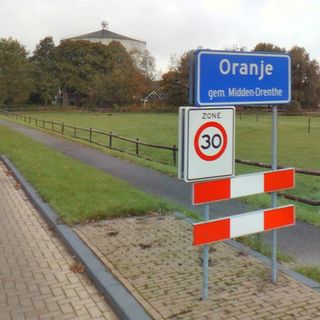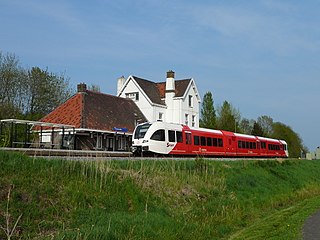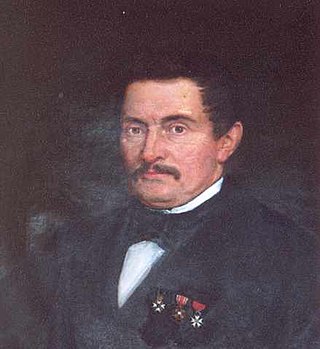
Hoogezand-Sappemeer is a former municipality in the Northeastern Netherlands. It was the third most-populous municipality in the province of Groningen, after Groningen and Oldambt. It was formed in 1949 by the merger of the former municipalities of Hoogezand and Sappemeer. On 1 January 2018, Hoogezand-Sappemeer merged with Slochteren and Menterwolde, forming the new municipality Midden-Groningen.

Sappemeer is a town in the Dutch province of Groningen. It is located in the municipality of Midden-Groningen to the east of Hoogezand.

Kropswolde is a village in the Dutch province of Groningen. It is located in the municipality of Midden-Groningen, about 3 km southwest of the town of Hoogezand and 5 km northeast of the town of Zuidlaren.

Martenshoek is a neighbourhood of Hoogezand and former village in the Dutch province of Groningen. It is located in the municipality of Midden-Groningen, about 2 km west of the town of Hoogezand.

Oranje is a village in the Dutch province of Drenthe. It is a part of the municipality of Midden-Drenthe, and lies about 13 km southwest of Assen.

Wijster is a village in the Dutch province of Drenthe. It is a part of the municipality of Midden-Drenthe, and lies about 11 km north of Hoogeveen.

Bovensmilde is a village in the Netherlands' province of Drenthe. It is a part of the municipality of Midden-Drenthe, and lies about six kilometers (3.7 mi) southwest of Assen.

De Punt is a village in the Dutch province of Drenthe. It is a part of the municipality of Tynaarlo, and lies about 11 km south of Groningen. The village closely cooperates with Yde and they are often referred to as Yde-De Punt, however both are still separate villages.

A hoogholtje is a typical footbridge in the Dutch province of Groningen. In the West of the Netherlands, the same model bridge is named kwakel, kwakker, or kwakeltje. In Friesland, the bridge type is known as a heechhout.

Noordbroek (Gronings:Noordbrouk) is a village in the Dutch province of Groningen. It is located in the municipality of Midden-Groningen, about 8 km northeast of Hoogezand.

Oude Pekela is a town in the Dutch province of Groningen. It is located in the municipality of Pekela, about 5 km southwest of Winschoten. It was established to exploit the peat in the area. During the 19th century, it was known for its maritime transport. During the 20th century, Oude Pekela became the centre of the cardboard and potato starch industry.

Windeweer is a former municipality in the Dutch province of Groningen. It existed until 1821, when it was merged with Hoogezand. Since 2018, it is part of Midden-Groningen. The villages of Windeweer and Kiel have grown together and are nowadays known as Kiel-Windeweer. Windeweer is the southern part of the village.

Kropswolde is an unstaffed railway station in Foxhol near Kropswolde in the Netherlands. The station was opened on 1 May 1868 and is located on the Harlingen–Nieuweschans railway between Groningen Europapark and Martenshoek in the province of Groningen. Train services are operated by Arriva.

Martenshoek is an unstaffed railway station in Martenshoek in the Netherlands. The station opened on 1 Jan 1905 and is located on the Harlingen–Nieuweschans railway between Groningen and Nieuweschans. The services are operated by Arriva.
The cooperative Royal Avebe U.A. is an international Dutch starch manufacturer located in the north of the Netherlands and produces starch products based on potato starch and potato protein for use in food, animal feed, paper, construction, textiles and adhesives.
The Moluccan diaspora refers to overseas Indonesians of Moluccan birth or descent living outside Indonesia. The most significant Moluccan diaspora community lives in the Netherlands, where it numbers c. 70,000 people as of 2018.

Midden-Groningen is a municipality with a population of 60,953 in the province of Groningen, Netherlands. The municipality was formed by the merger of former municipalities of Hoogezand-Sappemeer, Slochteren and Menterwolde on 1 January 2018 in the context of the municipal redivision in the province of Groningen 2013–2018.

Sutan Muhammad Djosan gelar Sutan Bidjo Radjo was an Indonesian bureaucrat. He was the Governor of Maluku from 1955 until 1960.

Willem Albert Scholten was a Dutch industrialist and landowner. He established the potato starch factory Eureka in Foxhol which laid the foundation of an industrial empire. Scholten would own 24 factories in Europe. He owned large plots of land in Drenthe for peat extraction, and was one of the founders of what would become the Holland America Line. In Groningen, Scholten built the Scholtenhuis, a large residential house on the Grote Markt, the main square, opposite the City Hall.

Kolham is a village in the Dutch province of Groningen. It is part of the municipality of Midden-Groningen. In 1959, natural gas was discovered at Kolham. Later, it was revealed that Groningen gas field was the largest natural gas field in Europe.






















